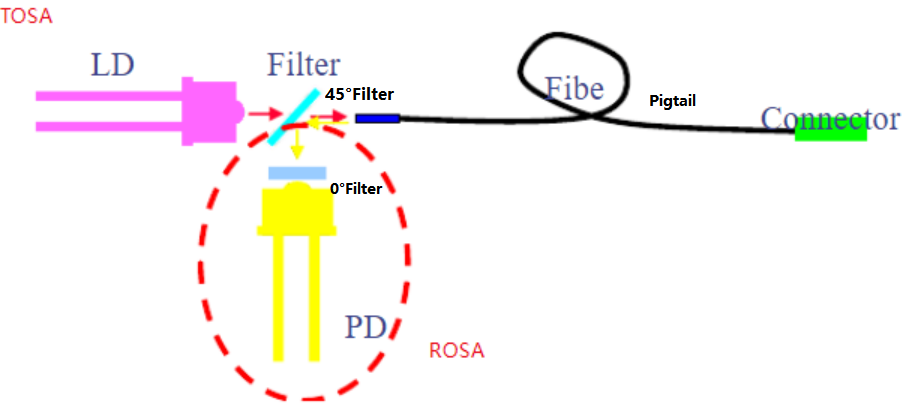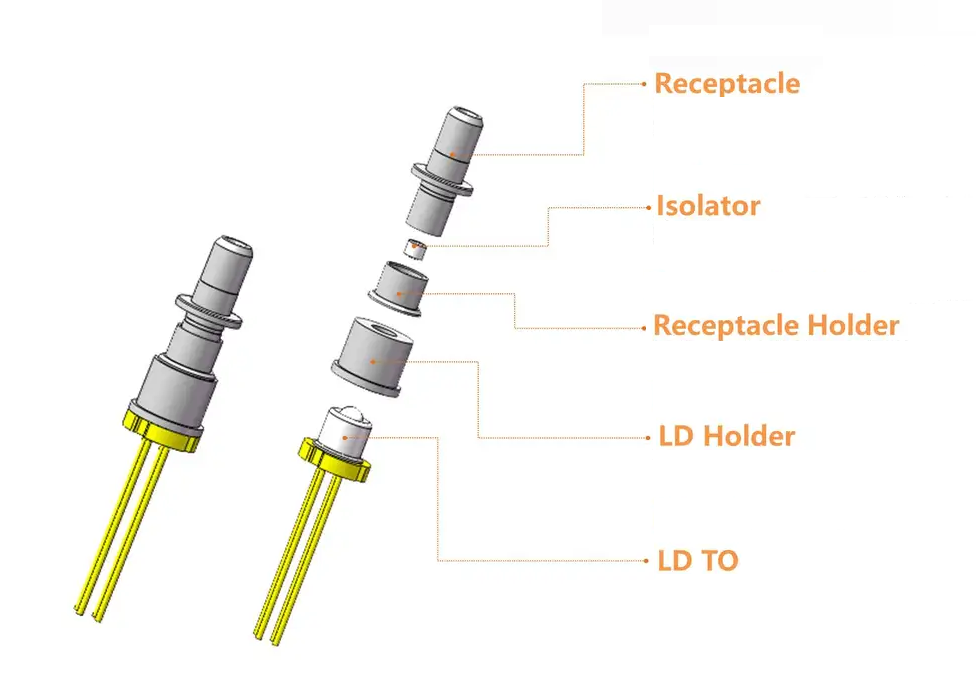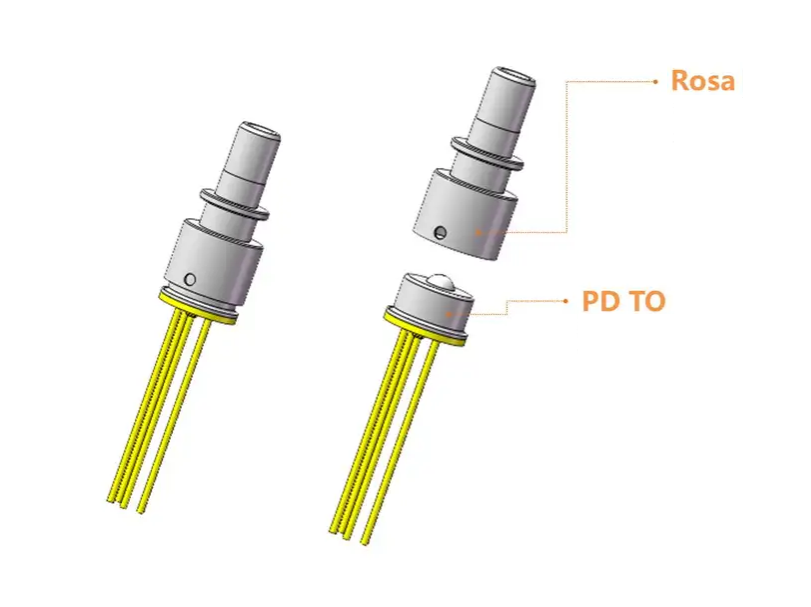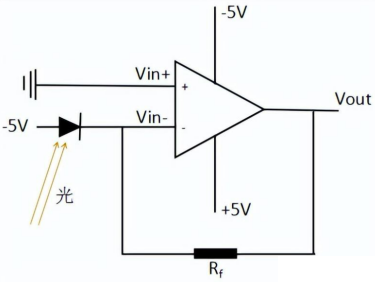Fiber Optic Tech
Fundamentals of BOSA Technology
Optical communication plays a crucial role in today's communication networks. Traditional twisted pair and coaxial cables suffer from high attenuation and the need for intermediate amplification over long distances, and their bandwidth is insufficient to meet the ever-increasing demands of high-speed communication. As a result, optical fiber transmission has become increasingly important. Optical fiber serves as the medium for transmitting light, while the devices responsible for optical transmission and reception are called optical modules or optical transceivers.
An optical module consists of optoelectronic devices, functional circuits, and optical interfaces. Optoelectronic devices include both transmitting and receiving components. The transmitter optical subassembly (TOSA) couples the laser generated by the TO into the optical fiber for transmission, while the receiver optical subassembly (ROSA) is responsible for detecting and receiving the optical signal transmitted from the optical fiber. Together, they are called Bidirectional Optical Subassembly (BOSA).
Composition of BOSA and functions of its components

Bidirectional data transmission over a single optical fiber means that the optical signal sent by the local laser and the optical signal transmitted from the remote end are simultaneously transmitted over the same optical fiber. To achieve this, the semiconductor laser (LD) and photodetector (PD) must be integrated optically to ensure that the transmitted and received light do not interfere with each other. By utilizing wavelength division multiplexing (WDM) technology, we can integrate the laser and photodetector to realize bidirectional communication over a single fiber.

A Transmitter Optical Subassembly (TOSA) is primarily composed of a laser, a submount, an adapter, and, in long-haul optical modules, an isolator and a tuning ring. Centered around a light source (such as a semiconductor light-emitting diode or laser diode), the TOSA encapsulates an LD chip, a monitor photodiode (MD), and other components in a compact package (TO can or butterfly package). The primary function of a TOSA is to convert electrical signals into optical signals (E/O conversion).

Laser Diode (LD): A semiconductor device that converts electrical energy into coherent light.
The light emission principle of a laser diode involves a P-N junction formed by two doped gallium arsenide layers. It features two planar ends, one of which is highly reflective (mirrored) and the other partially reflective. The wavelength of the emitted light is directly related to the length of the junction.
When a forward bias is applied to the P-N junction by an external voltage source, electrons move across the junction and recombine with holes, similar to a regular diode. During this recombination process, photons are emitted. These photons collide with atoms, triggering the release of more photons. As the forward bias current increases, more electrons enter the depletion region, resulting in a higher rate of photon emission.
Eventually, some photons randomly drifting within the depletion region strike the reflective surface perpendicularly, reflecting back along their original path. These reflected photons are then reflected again from the other end of the junction. This back-and-forth movement of photons occurs repeatedly. During this process, the avalanche effect causes more atoms to release more photons. This continuous reflection and amplification of photons lead to the generation of a very intense laser beam.
To achieve laser emission, the photons generated within the laser diode must possess identical energy levels, phases, and frequencies. This coherence results in a monochromatic laser beam. A critical condition for laser operation is that the diode current must exceed a specific threshold value (Ith). Below this threshold, the diode functions as an LED, emitting incoherent light.
Classification of laser diodes
Fabry-Perot (FP) lasers can be used with either single-mode or multi-mode fibers, offering high power and narrow spectral linewidth, making them suitable for long-distance applications. Unlike conventional diodes, FP lasers employ a resonant cavity structure. When a current is applied, electrons within the cavity undergo energy level transitions, emitting photons. The end faces of the cavity act as mirrors, causing photons to be confined within the cavity. As energy accumulates to a certain level, a laser beam is emitted. Consequently, a threshold current is required to initiate laser action.
Distributed Feedback (DFB) lasers have a similar structure and optoelectronic characteristics to Fabry-Perot (FP) lasers. To achieve optical transmission, they must operate above a threshold current. Most DFB lasers emit light at a wavelength around 1550 nm. Unlike FP lasers, DFB lasers have a grating structure along the external cavity, allowing only a single wavelength of light to exist within the cavity, known as a single longitudinal mode (SLM). This characteristic makes it easier to generate light with specific requirements, but at a higher cost.
Typical parameters of laser diodes
Threshold current: This is the current at which the laser diode begins to lase. For typical low-power laser diodes, this value is around several tens of milliamperes. Laser diodes with strained quantum well structures can have threshold currents as low as 10 mA or less.
Output optical power: The maximum allowable instantaneous optical power output. This parameter is applicable to both continuous wave (CW) and pulsed operation modes. However, please note that continuous high power operation can significantly reduce the lifetime of the emitting diode.
Feedback current: Monitor current through the PIN photodiode at rated output power.
Dark current: Dark current refers to the reverse bias current flowing through a device in the absence of incident light. It consists of leakage current caused by surface defects in the crystalline material and intrinsic dark current generated by the thermal diffusion of charge carriers. Dark current originates from electron-hole pairs generated by thermal excitation, primarily within the depletion region, but also at the depletion region edges due to the thermal diffusion of minority carriers, and at interfaces. The generation of dark current requires time, and the longer the potential well , the larger the dark current becomes. To minimize dark current, the storage and transfer time of signal charges should be shortened as much as possible. Dark current limits the sensitivity and dynamic range of imaging devices. Dark current is highly temperature dependent, decreasing by approximately half for every 10°C decrease in temperature.
Receiver Optical Subassembly (ROSA), primarily composed of a detector and an adapter, is commonly found in high-speed optical modules. It typically consists of a PIN or APD photodiode and a transimpedance amplifier (TIA) assembled in a sealed metal package. The ROSA is designed to convert optical signals into electrical signals (O/E conversion).

PD: A photodiode (PD) is a semiconductor device that converts incident light into an electrical current. In optical communication systems, the generated photocurrent is typically converted into a voltage signal by a transimpedance amplifier (TIA) for further processing. This configuration is commonly used in the receiver section.
Types of Photodiode
PIN-TIA: A PIN-TIA photoreceiver is a detection device used in optical communication systems to convert weak optical signals into electrical signals and provide low-noise amplification. It works by utilizing the photoelectric effect in a PIN photodiode, where incident light generates electron-hole pairs that are swept across the p-n junction under reverse bias, producing a photocurrent. This photocurrent is then amplified by a transimpedance amplifier (TIA), resulting in a voltage output. The characteristics of a PIN-TIA include dark current noise, which is non-negligible, and a decrease in photodetection performance with increasing temperature. A typical PIN-TIA circuit consists of a PIN photodiode and a transimpedance amplifier.

APD-TIA:An APD-TIA is a photodetector that utilizes an avalanche photodiode (APD) to convert weak optical signals into electrical signals. The APD operates under high electric field conditions, causing photogenerated electrons and holes to undergo impact ionization, resulting in an avalanche effect that significantly amplifies the photocurrent. This internal gain provides high sensitivity before electrical amplification. Due to its low dark current, the associated noise is negligible.
PIN photodiodes are characterized by their low cost and compatibility with standard electronic circuits. However, their quantum efficiency is lower than that of APDs, meaning they generate fewer electron-hole pairs per incident photon. In contrast, APDs utilize impact ionization to amplify the photocurrent, resulting in higher sensitivity and enabling the detection of weaker optical signals.
Typical specifications of photodiodes
Responsivity R, R = Ip/Pi, where Ip is the photocurrent generated by the photodetector and Pi is the incident optical power.
Breakdown voltage in reverse bias: The reverse voltage at which the reverse current reaches a predetermined value of 10uA in the absence of light.
Sensitivity: The lowest level of light a device can detect at a given wavelength, error rate, and speed.
Saturation: The highest level of light a device can handle without being overwhelmed at a given wavelength, error rate, and speed.



















